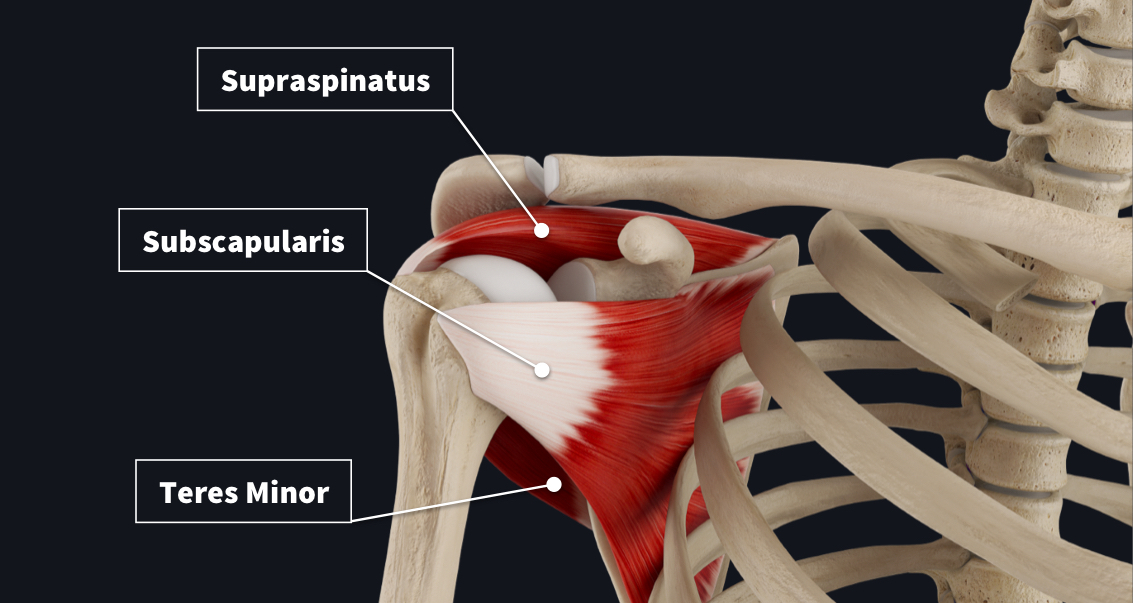The shoulder is the most commonly injured area of the body for fitness athletes. Whether rehabbing from an injury or trying to keep your shoulders healthy and avoid one, increasing rotator cuff strength should be a priority in your training.
Rotator Cuff Injuries 101
The rotator cuff comprises four muscles: the supraspinatus, subscapularis, infraspinatus, and teres minor. While each produces different motions like internal rotation, external rotation, or abduction, their primary role is to work as a team to provide stability to the shoulder joint.

The shoulder is a ball and socket joint. But the socket is very shallow like a golf tee. So the rotator cuff keeps the golf ball centered on the tee.
We see two primary forms of shoulder pain:
- First, rotator cuff muscle tendinopathy happens when these muscles are asked to do more work than they were prepared for. They get overloaded and broken down. We then progressively strengthen them to have them ready for the workload they are being asked to do.
- Second, we see shoulder instability issues (such as SLAP tears) when the rotator cuff isn’t able to effectively stabilize the golf ball on the golf tee. In this case, we’ll strengthen the rotator cuff muscles, but we’ll also work on the ability of the shoulder muscles to stabilize the shoulder joint.
The Best Rotator Cuff Strength Exercises
Side Lying Trio
The side lying trio is my favorite exercise to start with when an athlete has a highly irritable shoulder injury that isn’t tolerating much activity. A very light weight with this exercise will produce a serious burn to the posterior shoulder muscles.
Lewis Flexion
When athletes have pain reaching overhead, this exercise can often rapidly improve their shoulder mobility and reduce pain. Use a light elastic band loop and keep tension on the band as you reach overhead.
Seated Shoulder External Rotations
A commonly prescribed exercise for the shoulder, in the following video, I outline how I prefer to do Seated External Rotations to strengthen the shoulder but to also increase posterior glenohumeral joint mobility which often limits shoulder flexion range of motion.
IR Diagonal
Many individuals with rotator cuff pathologies focus on strengthening the back side of the shoulder (the infraspinatus and teres minor muscles). But the anterior cuff is often overlooked. My favorite rotator cuff exercise for the subscapularis is the IR Diagonal.
Scap Angels
These do a great job of strengthening the cuff and the muscles around the shoulder blade. I prefer doing these with double resistance bands crossed over each other.
Landmine Upright Row
Another commonly overlooked component of shoulder rehab is pulling a weight up. The landmine row does an excellent job of strengthening the shoulder. I like the landmine because the curved pattern that results hits the shoulder more and the biceps less than pulling a weight vertically.
Prone Swimmers
These are a brutally challenging exercise to perform. Fight to keep your hands as far away from the ground as possible as you “swim”.
Rotator Cuff Stability
As mentioned earlier, strength is only part of the equation of shoulder rehab. We must also train shoulder joint stability. Here are two of my favorite exercises.
Arm Bars
Arm bars are a challenging stability exercise. Focus on keeping your arm vertical as you roll from the starting position to your side. Use a weight that makes your arm shake a bit, but that you can still hold for 20-40 seconds per set.
Hanging Band Press
Hanging band technique work with an Earthquake Bar is so much harder than it appears. These will challenge you shoulder stability in the overhead position like no other exercise. Have fun!
\







